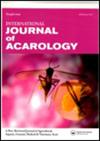印度喀拉拉邦西高止山脉Aralam野生动物保护区部落社区和野生动物中寻找和进食硬蜱(蜱螨:伊蚊科)的多样性和相对丰度的首次报告
IF 1
3区 农林科学
Q3 ENTOMOLOGY
引用次数: 0
摘要
摘要本研究是印度喀拉拉邦阿拉姆野生动物保护区首次报道蜱虫侵扰部落社区和野生动物的情况。保护区内的蜱虫是通过拖拽的方法收集的,而饲养动物的手部采集则用于收集正在进食的蜱虫。在总共收集的3081只蜱虫中,2350只是从森林地面采集的,731只是从属于四个物种的40种不同家畜中记录的。本次采集记录了八种血蜱:Ha。斯皮尼格拉,哈。李奇,哈。下岛。金奈利,哈。北安那山。turturis,哈。bispinosa,Ha。中间花和一个Amblyomma种:来自保护区的Am.integrum。而五种血蜱:哈。bispinosa,Ha。中间体,Ha。下岛。斯皮尼格拉,哈。turturis和四个Rhipipcephalus物种:Rh。Rh。赤藓类,Rh。microplus和Rh。据报道,家畜有环状体。高丰度的Kyasanur森林病(KFD)媒介,哈。斯皮尼格拉和哈。turturis在保护区有记载。Ha的相对丰度。在所有被检查的家畜中,双酚A显著较高。山羊的蜱虫感染率较高,其次是奶牛、狗和猫。而蜱虫的物种丰富度在奶牛中最高,在猫中最低。本文章由计算机程序翻译,如有差异,请以英文原文为准。
First report on diversity and relative abundance of questing and feeding hard ticks (Acari: Ixodidae) of the tribal communities and wildlife in Aralam Wildlife Sanctuary of Western Ghats, Kerala, India
ABSTRACT The present study is the first report on ticks infesting domestic animals of the tribal communities and wildlife in Aralam Wildlife Sanctuary, Kerala, India. Questing ticks in the sanctuary were collected through dragging methods and hand collection from domestic animals was used to collect feeding ticks. Among the total 3,081 ticks collected, 2,350 questing ticks were obtained from the forest floor, and 731 ticks were recorded from 40 different domestic animals belonging to four species. The present collection recorded eight Haemaphysalis species: Ha. spinigera, Ha. leachii, Ha. shimoga, Ha. kinneari, Ha. kyasanurensis, Ha. turturis, Ha. bispinosa, Ha. intermedia and one Amblyomma species: Am. integrum from the sanctuary. Whereas five Haemaphysalis species: Ha. bispinosa, Ha. intermedia, Ha. shimoga, Ha. spinigera, Ha. turturis and four Rhipicephalus species: Rh. sanguineus, Rh. haemaphysaloides, Rh. microplus and Rh. annulatus were reported from domestic animals. High abundance of Kyasanur Forest Disease (KFD) vectors, Ha. spinigera and Ha. turturis have been documented from the sanctuary. Relative abundance of Ha. bispinosa was significantly higher in all the domestic animals examined. Tick infestation rate was higher in goats followed by cows, dogs, and cats. Whereas the species richness of ticks was highest in cows and lowest in cats.
求助全文
通过发布文献求助,成功后即可免费获取论文全文。
去求助
来源期刊
CiteScore
2.20
自引率
9.10%
发文量
60
审稿时长
6-12 weeks
期刊介绍:
The International Journal of Acarology has a global readership and publishes original research and review papers on a wide variety of acarological subjects including:
• mite and tick behavior
• biochemistry
• biology
• control
• ecology
• evolution
• morphology
• physiology
• systematics
• taxonomy (single species descriptions are discouraged unless accompanied by additional new information on ecology, biology, systematics, etc.)
All submitted manuscripts are subject to initial appraisal by the Editor. If the English is not of a quality suitable for reviewers, the manuscript will be returned. If found suitable for further consideration, it will be submitted to peer review by independent, anonymous expert referees. All peer review is single blind.

 求助内容:
求助内容: 应助结果提醒方式:
应助结果提醒方式:


